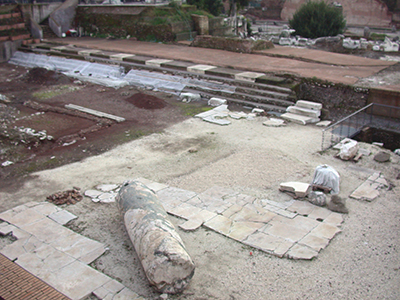
Among the spoils of the Jewish War paraded through the center of Rome in the summer of 71 C.E. was the Temple Menorah, depicted in this deeply carved relief panel from the Arch of Titus in Rome, which was erected for the victorious general (and later emperor) to permanently commemorate his major accomplishment. Photo: Courtesy Steven Fine, The Arch of Titus Project.
After quelling a dangerous revolt in the Roman province of Judea in 71 C.E., Emperor Vespasian and his son Titus returned to Rome to publicly celebrate their victory. Following an ancient martial tradition, they marched victoriously through the city center in a riotous triumphal procession, parading prisoners and spoils of the war.
To commemorate this Roman triumph and to honor the victorious general (and later emperor), Titus, Emperor Domitian built an honorific monument—the Arch of Titus, which stands on the main processional street of ancient Rome (Via Sacra) to this day. The relief panels of the Arch of Titus in Rome chronicle the triumphal episodes following the fall of Jerusalem, capturing prominently the triumphal procession. One of the scenes confirms that the Temple Menorah was carried on litters in the parade that took place in the summer of 71 C.E. But what happened to the seven-branched candelabrum after that? The possibilities are explored in detail in the article “Did the Temple Menorah Come Back to Jerusalem?” in the September/October 2017 issue of Biblical Archaeology Review, where Fredric Brandfon unravels the Menorah’s intricate story.
The first-century C.E. Jewish historian Flavius Josephus informs us that after the triumph—depicted so famously on the Arch of Titus in Rome—most of the Temple treasures were deposited in the newly built Roman Temple of Peace.1 Josephus rather vaguely mentions “those golden vessels and instruments that were taken out of the Jewish temple.” Was the Temple Menorah among these artifacts?
The Roman Temple of Peace was apparently a magnificent building that Emperor Vespasian built “in so glorious a manner, as was beyond all human expectation and opinion” and had “adorned with pictures and statues.”2 It is then no wonder that the Roman polymath Pliny considered this Roman Temple of Peace among the most beautiful buildings in the city.
Herod’s desert fortress on the mountaintop of Masada was made famous as the site of the last stand between the besieged Jewish rebels and the relentlessly advancing Romans at the conclusion of the First Jewish Revolt. In the free ebook Masada: The Dead Sea’s Desert Fortress, discover what archaeology reveals about the defenders’ identity, fortifications and arms before their ultimate sacrifice.
Yet we can only speculate that the Temple Menorah was among the Temple spoils and “all such rarities” (as Josephus puts it) collected from every part of the Roman Empire and displayed for public viewing in the Roman Temple of Peace.
The only time the Temple Menorah reappears in our records (after it had been portrayed on the Arch of Titus in Rome in c. 81 C.E.) is when a second-century rabbi Simeon ben Yohai travels to Rome, where he reportedly sees the Menorah. Where precisely? Presumably in the Roman Temple of Peace. This temple then burned down around 192 C.E. It was later rebuilt, but we never again hear of the Temple Menorah.

Only ruins remain of the Roman Temple of Peace that once housed the spoils of the Jerusalem Temple, according to Flavius Josephus’s The Jewish War. Was the Temple Menorah among these treasures? It must have been, although no historical source mentions it explicitly. But would the Temple Menorah have survived the fire that destroyed this pagan temple around 192 C.E.? If so, what followed?
If the Temple Menorah survived the destruction of the Roman Temple of Peace, what happened to it after the sack of Rome by Visigoths in 410 and by Vandals in 455? Is it even possible that the Menorah survived all the calamities and chaos of the fifth and sixth centuries? A tradition recorded by the Byzantine historian Procopius of Caesarea (c. 500–560) has it that the Temple treasures eventually ended up back in Jerusalem.3 Procopius relates that Emperor Justinian returned the spoils of the Temple to Jerusalem because they were cursed—any city that once housed them was eventually destroyed. Could the Temple Menorah have still been part of the Temple treasures at that point in history and thus found its way back to the holy city?
Through an in-depth examination of historical accounts, obscure Jewish writings and traditions, Fredric Brandfon tells the fascinating story of the Temple Menorah in his article “Did the Temple Menorah Come Back to Jerusalem?” in the September/October 2017 issue of Biblical Archaeology Review.
Not a BAS Library member yet? Join the BAS Library today.
A version of this post first appeared in Bible History Daily in 2017
Notes:
1. Josephus, The Jewish War 7.158–162.
2. Ibidem.
3. Procopius, The Wars of Justinian, trans. by Henry B. Dewing, introduction and notes by Anthony Kaldellis (Indianapolis & Cambridge: Hackett Publishing Co., 2014), 4.9.6–9.
Related reading in Bible History Daily:
On Display in Rome: Images of the Temple Menorah
The Arch of Titus’s Menorah Panel in Color
What Did Herod’s Temple in Jerusalem Look Like?
Jewish Captives in the Imperial City
The post Where Did the Temple Menorah Go? appeared first on Biblical Archaeology Society.

0 Commentaires